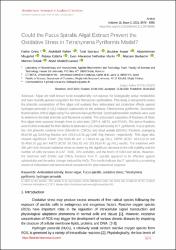Could the Fucus Spiralis Algal Extract Prevent the Oxidative Stress in Tetrahymena Pyriformis Model?

View/
Date
2021Author
Grina, FatihaRahim, Abdellatif
Sabraoui, Talal
Nasser, Boubker
Moujahid, Abderrahman
Eddoha, Rabiaa
Essamadi, Abdel Khalid
Metadata
Show full item recordAbstract
Algae are well-known to be exceptionally rich sources for biologically active metabolites and have recently gained recognition for their therapeutic applications. This study is designed to assess the phenolic composition of five algae and evaluate their antioxidant and protective effects against hydrogen peroxide (H2O2) induced cytotoxicity in the protozoa Tetrahymena pyriformis. Successive fractionations of five algae using five solvents were performed. Spectrophotometric methods were used to determine the total phenolic and flavonoid contents. The antioxidant capacities of fractions of these five algae were assessed through three in vitro tests (DPPH, ABTS, and FRAP). The active fractions were further evaluated for their ability to attenuate H2O2 induced toxicity in T. pyriformis. Fucus spiralis has rich phenolic contents from chloroform (CHCl3) and ethyl acetate (EtOAc) fractions, averaging 65 +/- 0.90 mu g GAE/mg fraction and 429.81 +/- 9.36 mu g GAE /mg fraction, respectively. This algae also showed significant FRAP (261.53 +/- 5.40 and 117.66 +/- 0.40 mu g /mL), DPPH (IC50: 49.51 +/- 3.29 and 55.48 +/- 0.20 mu g) and ABTS (IC50: 50.73 +/- 2.62 and 219.82 +/- 5.47 mu g /mL) results. The treatment with 300 mu M H2O2-induced oxidative stress as shown by the significant decrease in the cell viability and the number of cells increases in CAT, SOD, GPx activities, and the levels of GSH and MDA. However, the treatment with EtOAc and CHCl3 fractions from F. spiralis appeared to be effective against cytotoxicity and the redox changes induced by H2O2. The results indicate that F. spiralis is a promising source of antioxidant and nutraceutical compounds for pharmaceutical purposes.

















